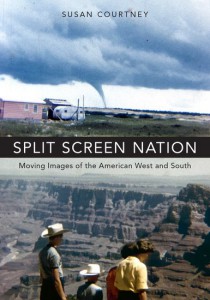Split Screen Nation
Moving Images of the American West and South


Average rating: ![]()
| 0 | rating | |
| 0 | rating | |
| 0 | rating | |
| 0 | rating |
Your rating: -
Book Presentation:
• Offers new conceptual framework for thinking about region and nation in U.S. culture
• Analyzes a newly expansive archive of moving images
• Fuses diverse methods in film and media studies
Split Screen Nation traces an oppositional dynamic between the screen West and the screen South that was unstable and dramatically shifting in the decades after WWII, and has marked popular ways of imagining the U.S. ever since. If this dynamic became vivid in Quentin Tarantino's Django Unchained (2012), itself arguably a belated response to Easy Rider (1969), this book helps us understand those films, and much more, through an eclectic history of U.S. screen media from the postwar era. It deftly analyzes not only Hollywood films and television, but also educational and corporate films, amateur films (aka "home movies"), and military and civil defense films featuring "tests" of the atomic bomb in the desert. Attentive to sometimes profoundly different contexts of production and consumption shaping its varied examples, Split Screen Nation argues that in the face of the Cold War and the civil rights struggle an implicit, sometimes explicit, opposition between the screen West and the screen South nonetheless mediated the nation's most paradoxical narratives — namely, "land of the free"/land of slavery, conquest, and segregation. Whereas confronting such contradictions head-on could capsize cohesive conceptions of the U.S., by now familiar screen forms of the West and the South split them apart to offer convenient, discrete, and consequential imaginary places upon which to collectively project avowed aspirations and dump troubling forms of national waste. Pinpointing some of the most severe yet understudied postwar trends fueling this dynamic — including non-theatrical film road trips, feature films adapted from Tennessee Williams, and atomic test films — and mining their potential for more complex ways of thinking and feeling the nation, Split Screen Nation considers how the vernacular screen forms at issue have helped shape how we imagine not only America's past, but also the limits and possibilities of its present and future.
About the Author:
Susan Courtney, Associate Professor, Film and Media Studies, University of South Carolina Susan Courtney is an associate professor of Film and Media Studies and English at the University of South Carolina. There she also co-founded the Orphan Film Symposium and has directed the program in Film and Media Studies. She is the author of Hollywood Fantasies of Miscegenation: Spectacular Narratives of Gender and Race, 1903-1967 (2005).
Press Reviews:
Winner of the 2018 Kraszna-Krausz Best Moving Image Book Award
See the publisher website: Oxford University Press
> From the same author:
Hollywood Fantasies of Miscegenation (2004)
Spectacular Narratives of Gender and Race, 1903-1967
Subject: Sociology
> On a related topic:
Filmlandia! (2023)
A Movie Lover's Guide to the Films and Television of Seattle, Portland, and the Great Northwest
Subject: Countries > United States
Imagining the American Death Penalty (2025)
The Cultural Work of Popular Visual Representations
by Birte Christ
Subject: Countries > United States
Generation Tarantino (2025)
The Last Wave of Young Turks in Hollywood
Subject: Countries > United States
Policing Show Business (2024)
J. Edgar Hoover, the Hollywood Blacklist, and Cold War Movies
Subject: Countries > United States
Law at the Movies (2024)
Turning Legal Doctrine into Art
by Stanley Fish
Subject: Countries > United States
Our Country/Whose Country? (2024)
Early Westerns and Travel Films as Stories of Settler Colonialism
by Richard Abel
Subject: Countries > United States